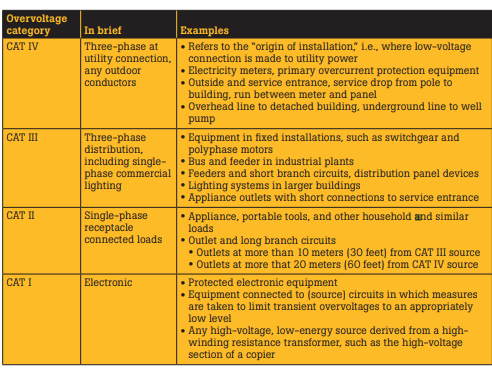
Please note this blog was originally published on the 12th October 2012. It was updated on the 21st July 2025.
If you’ve ever bought electrical test equipment, you'll have seen that it is given a safety or CAT rating. This is usually defined as one of four categories and each category tells you under which electrical situations the tester can be safely.
It is important to have an understanding of CAT ratings and how each one will affect the kind of installation, testing, or troubleshooting you'll be safe to perform.
The first thing you need to know about using equipment outside of its designated safety rating is that it can be extremely dangerous. The second thing is that can throw off the accuracy of tests results, hence why it is so important to use appropriately CAT-rated tools.
Quick Links
The Difference Between CAT Ratings
Below is a table[1] and explainations offering a breakdown of CAT ratings category by category.

Measurement Category I (CAT I)
This category refers to anything that is used for measuring voltages from specially protected secondary circuits. Examples of this include signal levels, special equipment, limited-energy parts of equipment, circuits powered by regulated low-voltage sources and other electronics.
These devices are not intended to be connected to the mains supply. It is uncommon to see CAT I referenced on equipment; as the available energy is so low. Instead, many manufacturers put rated voltage and current values.
Measurement Category II (CAT II)
CAT II is used to define circuits which are intended to be connected into mains sockets, or any other similar points. Any energy output must be limited to below 100 A continuously, although it can be changed to 500 A for voltages not exceeding 150V.
Generally CAT II testers are used to check household appliances, portable tools and similar modules.
Measurement Category III (CAT III)
You need a CAT III-rated tester to measure fixed or hard-wired equipment such as general wiring, bus bars, junction boxes, switches, socket outlets, etc.
Measurement Category IV (CAT IV)
CAT IV is the highest safety rating available. It is necessary when testing any equipment or systems directly connected to a building's source of power. This is because of high energy levels and the increased risk of arc flash. For example, CAT IV-rated instruments would be required when testing a cables that connects a power transformer to a building.
Further Information
For help and advice regarding CAT ratings or any of our test equipment, thermal cameras, and tools, please contact our Sales team on 01642 931 329 or via our online form.
Browse Electrical Test Equipment
Alternatively, for a detailed explanation of CAT categories, please download's Fluke's paper on multimeter safety.
Download Fluke's ABCs of Multimeter Safety
Footnotes
[1] The table is taken from Fluke, ABCs of multimeter safety: Multimeter safety and you, last accessed 21st July 2025.


